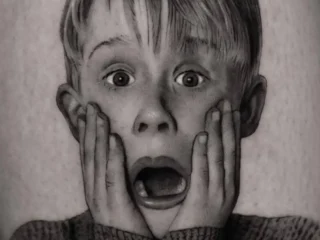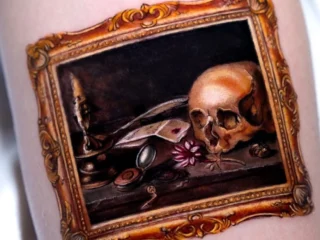Inked Mag Staff
June 26th, 2015
Take a Step Back Into Tattooing’s Past
Photo Gallery Follows the Text Judging by first impression New York’s Daredevil Tattoo is just like any of the other shops in the nation’s largest city. All the typical sounds…

Photo Gallery Follows the Text
Judging by first impression New York’s Daredevil Tattoo is just like any of the other shops in the nation’s largest city. All the typical sounds are there—the buzz of a machine hard at work, music playing from the speakers and laughter and conversation coming from the stations in the back. Then you start to notice the walls. Like other tattoo shops they are covered in flash, but uniquely this flash isn’t from the resident artists and it’s encased in glass. It’s flash from some of the giants of the early days of tattooing and serves as the centerpiece of the NYC Museum of Tattooing History.
Daredevil Tattoo is located only steps away from the Bowery, which puts it in the same neighborhood where Martin Hildebrandt set up shop over 150 years ago to become the first tattooer in the United States. It is this proximity to where it all went down combined with a photo of Hildebrandt in their collection that hooked shop co-owner Michelle Myles on the idea of creating the museum.
“I was able to find exactly where his shop was,” Myles says with excitement. “If you stand in the spot where it was you are looking right out at the East River and the Brooklyn Bridge. I was like, Wow, I’m standing here and I’m back in time. It’s so real to this place.”
And finding the shop was no easy task. Tattooers have never been known for a love of record keeping so it was quite a chore to track down any official record of Hildebrandt’s career. Eventually Myles was able to find a city directory from 1859 (the equivalent of a phone book a couple of decades before the phone was invented) with the following listing—Martin Hildebrandt, tattooing. Now that Myles knew the shop was located on Oak Street all she had to do was go there. Of course, it couldn’t be that easy, there is no Oak Street in modern Manhattan.

Within 30 seconds of speaking with Myles her enthusiasm is overwhelming, so it comes as no surprise that a hurdle like a street no longer existing barely even slowed her quest for knowledge down. Putting together the museum has been a labor of love for Myles and her co-owner Brad Fink.
“This profession is something that we have poured our hearts and souls into,” Myles says. “Being a tattooer becomes part of your whole identity. All of my friends are tattooed, we’re a tight knit community, to have the opportunity to have this place where people can come in and learn about where tattooing started in the place where it started is a huge privilege.”
Fink had been putting the impressive collection together over the last 20 years. It had been sitting in his house where very few people were able to see it, and presumably it cluttered the place up considering how much there is. Now the vast collection is on display for anyone with a desire to learn a little history.
And what a collection it is. You can trace the entire history of tattooing in New York City as you walk deeper into the shop. Right inside the door is a tattoo machine designed by Samuel O’Reilly, the man who famously improved upon Thomas Edison’s electric pen and patented the first tattoo machine. From there you can see machines designed by Charles Wagner. If they weren’t in a case you might think that one of the artists had just left a band new machine laying around, the design is so similar to what you find today.

As Myles walks through the shop there is a story attached to every artifact. One thing that seemed to connect all of the old time artists was how so many of them seemed to run supply companies on the side. In an age where you can get everything you need to become a tattooer (other than skill and training, that is) on the internet and delivered to your door within hours it’s easy to forget how difficult it used to be.
“Originally everybody was making and fabricating all of their own stuff,” Myles explains. “At some point you had some people who started building machines for their buddies. Then there were some companies like Zeis in Chicago that would advertise in the back of magazines like Popular Mechanics.”
Both Fink and Myles used to call St. Louis home and their upbringing fostered a love for one of the giants of the industry who hailed from their hometown—Bert Grimm. The museum is home to multiple cases of Grimm’s flash, much of it instantly recognizable to anyone who has an affinity for American Traditional tattooing. Two of the most notable pieces of Grimm’s flash in the collection have burn marks on them, a sign that they were pulled from a fire that consumed the legend’s tattoo shop.

Those singed posters serve as a reminder of one of the reasons that this collection is so culturally important; for years no one would have considered old tattoo paraphernalia to be of any value. This leads to a couple of reasons why it’s so rare to find some of the things that are housed in this collection. First off is that since the artwork had very little value other than when it was inked into someone’s skin the old time tattooers weren’t using high quality paper for their flash, they weren’t trying to preserve anything. They were using whatever they had and over the years they don’t hold up. More importantly, often when a tattooer would pass away those that inherited the collection wouldn’t see any value in it and toss it out. For example, when Charlie Wagner died the city of New York emptied out his shop and sent everything to the dump. Imagine the historical treasure trove that shop would have been if it was looked at in a slightly different manner.
Of course, one shouldn’t dwell on the history that got away when so much of it is here. The centerpiece of the entire museum is one very recognizable painting.
“I can’t even believe that the Sundancer is here,” Myles says as she points to the Bert Grimm painting on the wall. If you spend enough time among tattooed people you will see tattoos of the Sundancer show up quite often. “It’s such an iconic piece, there are so many people getting that tattooed as backpieces now. It’s so cool to be able to come here and actually see the original. I can’t believe that she lives here now.”

As mentioned before, gathering a collection like this is a labor of love, but it is also a pricey endeavor to undertake. Keeping a tattoo shop afloat is tough enough on its own when you aren’t dedicating a huge chunk of space to a museum. To help offset some of the cost the Daredevil team has incurred when putting the museum together they have set up a Kickstarter. If you have any interest in the tattooing history of NYC, or really of the United States as a whole, it is very worthwhile to check it out. There are some pretty cool rewards attached to the campaign including a map of tracing back the history of New York tattoo shops all the way back to Hildebrandt’s place that started it all.
If you want to see the collection head on over to Daredevil Tattoo at 141 Division Street, NYC. In the gallery below you can get a sneak peak of some of the collection. Consider supporting the Kickstarter by clicking here.
Editor's Picks
Bridging Classical Art and Modern Tattooing
Esteban Rodriguez brings the discipline of classical fine art to the living canvas of skin, creating hyper-realistic tattoos that merge technical mastery with emotional depth.
Show Your Ink Fashions Brings Custom Style to Tattoo Culture
Show Your Ink Fashions creates custom shirts designed to showcase your tattoos as wearable art, blending fashion with personal expression.
The Ultimate “Superman” Tattoo Roundup: Just in Time for Superman’s Return to Screens
With Superman’s big return to theaters, fans are revisiting some of the most iconic ink inspired by the Man of Steel.














